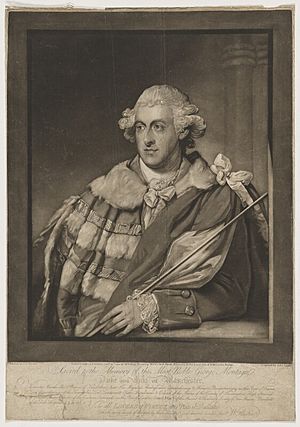George Montagu, 4th Duke of Manchester facts for kids
Quick facts for kids
The Duke of Manchester
|
|
|---|---|

1790 print by John Jones, published by William Austin, after a portrait by Gilbert Stuart
|
|
| British Ambassador to France | |
| In office 1783–1784 |
|
| Preceded by | Alleyne FitzHerbert |
| Succeeded by | The Duke of Dorset |
| Member of Parliament for Huntingdonshire | |
| In office 1761–1762 Serving with The Lord Carysfort
|
|
| Preceded by | Coulson Fellowes The Lord Carysfort |
| Succeeded by | The Lord Carysfort Lord Charles Montagu |
| Personal details | |
| Born |
George Montagu
6 April 1737 |
| Died | 2 September 1788 (aged 51) |
| Political party | Whig |
| Spouse |
Elizabeth Dashwood
(m. 1762) |
| Children | 6, including Caroline, William, Frederick |
| Parent | Robert Montagu, 3rd Duke of Manchester |
George Montagu, 4th Duke of Manchester (born April 6, 1737 – died September 2, 1788) was an important British politician and diplomat. A diplomat is someone who represents their country in other nations. He held the title of Duke of Manchester, which is a high rank in the British nobility. He was also a member of the Privy Council, a group of advisors to the British monarch.
Contents
Early Life and Family
George Montagu was the son of Robert Montagu, 3rd Duke of Manchester. His mother was Harriet Dunch. He had several brothers and sisters. One of his brothers was Lord Charles Montagu.
His family was well-known in Britain. His grandparents were Charles Montagu, 1st Duke of Manchester and Dodington Greville. His uncle, William Montagu, 2nd Duke of Manchester, also held the title of Duke before his father.
Becoming a Leader
Just like his father, George Montagu became a Member of Parliament (MP) for Huntingdonshire. An MP is someone elected to represent an area in the British Parliament. He served from 1761 to 1762. In 1762, he inherited his father's title and became the 4th Duke of Manchester.
As Duke, he hired a famous architect named Robert Adam to work on his main home, Kimbolton Castle.
Roles in Government
George Montagu held several important jobs in the British government:
- He was a Collector of Subsidies in the Port of London in 1762. This meant he helped collect taxes on goods coming into London.
- He served as a Lord of the Bedchamber from 1762 to 1770. This was a personal attendant to the King.
- From 1782 to 1783, he was the Lord Chamberlain of the Household. This role involved managing the royal household.
He was a member of the Whig political party. The Whigs were a major political group in Britain at the time. He strongly disagreed with Lord North's policies regarding America.
Ending the American War
In 1783, George Montagu was chosen to be the British Ambassador to France. His main job was to help finish the peace talks between Great Britain, France, Spain, and the Netherlands.
He played a key role in ending the American Revolutionary War. He signed the Peace of Paris at Versailles for Great Britain. This treaty officially ended the war and recognized the independence of the United States.
Other Important Positions
Besides his government roles, he was also:
- The Lord Lieutenant of Huntingdonshire from 1762 until his death in 1788. A Lord Lieutenant is the King's personal representative in a county.
- The Grand Master of the Freemasons from 1777 to 1782. The Freemasons are one of the oldest and largest fraternal organizations in the world.
Personal Life
On October 22, 1762, George Montagu married Elizabeth Dashwood. She was the daughter of Sir James Dashwood, 2nd Baronet.
They had several children together, including:
- George Montagu, Viscount Mandeville (1763–1772), who sadly died when he was young.
- Lady Caroline Maria Montagu (1770–1847).
- William Montagu, 5th Duke of Manchester (1771–1843), who later became the 5th Duke.
- Lord Frederick Montagu (1774–1827).
- Lady Emily Montagu (died 1838), who worked as the Housekeeper of Hampton Court Palace.
George Montagu faced financial difficulties. In 1767, he had to sell his family's London home in Berkeley Square.
The Duke of Manchester passed away on September 2, 1788, after a short illness. His wife, the Dowager Duchess of Manchester, died much later in 1832.

